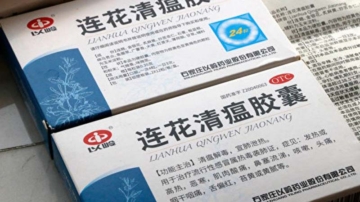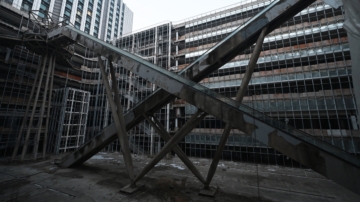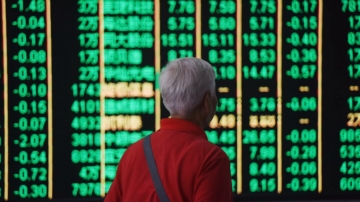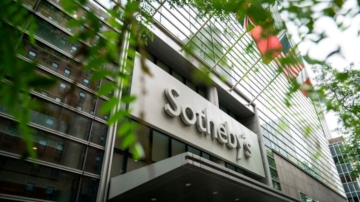【新唐人2014年05月19日讯】根据中共银行业监督管理委员会15号发布的最新资料显示,截至今年一季度末,商业银行不良贷款馀额达到6461亿元人民币,创下了近三年来的最高水准。不良贷款率的上升,反映了中国经济增长放缓,经济下行的现状。那么,中国经济发展趋势到底会怎样呢?请看以下报导。
中国银监会网站15号发布的资料说,中国银行业第一季度末不良贷款率增加541亿元,达到了1.04%。这也是连续十个季度的上升。
根据大陆的监管规定,不良贷款,就代表着借款人无法足额偿还借款。
浙江财经大学经济与国际贸易学院院长谢作诗:“中国经济一直泡沫化、高杠杆化。那么,经济现在去杠杆化、去泡沫化的过程中,房价在下行、经济在下行,那当然坏账会产生。我认为随着房价经济进一步下行,这个潜在的坏账还会增加。”
大陆《财经网》指出,由于整个融资体系的风险,绝大部分都压在银行业身上,一旦资金链断裂,必然会发生系统风险。《财经网》认为,种种信号显示,银行风控的警报已经拉响。
实际上,根据中共公开的资料显示,2010年银行业的净利润为7637亿元,年增长率为14.26%﹔2011年是10412亿,年增长率高达36.34%﹔而到了2012年,银行的净利润达到了12386亿,2013年也是超过1万1千多亿元。
按理来讲,1%左右的不良贷款率完全可以被覆盖。但银监会在4月29号召开的2014年第一季度经济金融形势分析会上,非常强调严格对不良贷款馀额和比率“双控”管理。
台湾证券分析人士Jack徐认为,从去年6月以来,银行间的拆借利率大幅度飙升,出现钱荒,说明银行贷款到期收不回来。真实反应了银行的困境。
台湾证券分析人士Jack徐:“看一个国家或者一个地区的真正的不良放款或呆帐它的真实情况,坦白来讲,去观察它的隔天拆款利率,在当下,应该算是一个比较客观的标准。”
Jack徐指出,不良贷款把大陆的经济打回了原形。他说,以前的表面经济增长,是建立在大规模的贷款上,不是真实的繁荣。
而大陆金融分析师任中道指出,从去年开始银行收紧信贷的信号中,也可以看出银行真是遇到麻烦了。
大陆金融分析任中道:“中共的这些数据都是不准确的,都是有水份的。相关的机构还有学者都已经曾经统计过,也就是说它的不良贷款率,其实没有它说的那么低。”
《法国兴业银行》去年底估算,如果考虑到产能过剩、中小城市房地产泡沫等潜在因素的负面影响,中国银行业不良贷款率可能已经接近10%,也就是6万多亿,远高于官方公布的1%的水准。
其实,《杭州银行》去年的年报显示,不良贷款馀额为20亿5900万元,年增加5亿7700万元,不良贷款率为1.19%﹔但《杭州银行》在去年底还有没有偿还的到期贷款,高达41亿8000万元,同比暴增153%。
“浙江财经大学经济与国际贸易学院”院长谢作诗指出,中国银行是国有的,有他的特殊性,也就是可以让全国人民一起来还债。
谢作诗:“我估计大规模的挤兑行为、银行倒闭行为可能性不大。不大的原因并不是说泡沫化银行的潜在坏账不严重,而是说政府它可以用超发货币,像剥离不良资产等等一些办法去救。”
不过,任中道指出,中共高层早就发现金融系统出问题了,他们也早释放出解决的办法来,那就是即将推出的银行破产条例。
今年一月,银监会副主席表示,银监会正酝酿加快推出银行破产条例。而业内人士也指出,今年内,银行破产条例很可能推出。
一旦银行破产,大陆储户们的钱将血本无归。
采访/易如 编辑/宋风 后制/李智远
----------
Non-Performing Loans Continued to Increase: Banks On Alert
On May 15, the Chinese Communist Party (CCP) Banking Regulatory Commission launched it’s latest data. By the end of the first quarter of this year, the balance of non-performing loans (NPL) for commercial banks reached 646.1 billion yuan. This marked a record for the highest level in nearly three years. The rise of non-performing loan ratios is reflective of the current situation with the slowdown of China's economic growth, and of an economic downturn. How will the the Chinese economy continue to trend? Please see the following report.
On May 15, the China Banking Regulatory Commission (CBRC) website released it’s latest information. By the end of the first quarter of China's banking sector, the NPL ratio increased by 54.1 billion yuan, reaching 1.04%. This now reflects a rise over ten consecutive quarters.
In accordance with mainland China’s regulatory requirements, non-performing loans mean the borrower cannot repay loans.
Xie Zuoshi, Dean of the Faculty of Economics and International Trade, Zhejiang University of Finance: “China’s economy is a bubble, and is highly leveraged. The economy is now going through a de-leveraging process, with a downturn in house prices and the economy. This will of course produce bad debts. I think that with house prices taking a further downturn, the potential for bad debts will increase.”
Mainland China’s ‘Financial Network’ points out that, because of the vast majority of the risk in the entire financing system leaning on the banking industry, once a funding strand breaks, it is bound to create systemic risk. The Financial Network believes that a variety of signals shows that the bank’s risk control has pulled the alarm.
In fact, according to information published by the CCP, banking net profits in 2010 were 763.7 billion yuan. This marked an annual growth rate of 14.26%. In 2011, it was 1.0412 trillion, with an annual growth rate of 36.34%. In 2012, banking net profits reached 1.2386 trillion, and in 2013 it similiarily exceeded 1.1 trillion yuan.
Logically, about 1% NPL ratio can be overwritten. But on April 29, in it’s 2014 first quarter economic and financial situation analysis meeting, the CBRC very strictly emphasized the ‘duel control’ management on balance and ratio of NPL.
Jack Xu, a Taiwan Securities analyst, believes that since last June, the dismantling rate had a significant surge between banks. Money shortages occurred, indicating the maturity of bank loans are not being paid, reflecting the true plight of banks.
Jack Xu, Taiwan Securities Analyst: “To look at the actual bad loans and debts in a country or region, frankly speaking, is to observe its next call rate. At the moment, this should be considered as more objective criteria.”
Jack Xu points out that the NPL shows the real situation of China’s economy. He said that previously, the superficial economic growth was built on massive loans, not real prosperity.
Mainland financial analyst Ren Zhongdao suggests that from the beginning of last year, banks have tightened credit, which also reveals the banks are really in trouble.
Ren Zhongdao, Mainland Chinese financial analysis: “The CCP's data is inaccurate, and it is all inflated. Related institutions and scholars have calculated that NPL ratio, in fact, is not as low as suggested.
The French bank Societe Generale gave last year’s estimates. Taking into consideration negative impacts, such as excess capacity, and medium and small cities’ real estate bubbles, Chinese banks NPL ratio may have been close to 10%. This is over 6 trillion, and is much higher than the official announced 1% level.
The Annual Report from Hangzhou Bank last year showed that NPL amounted to 2.059 billion yuan. This marked an annual increase of 577million yuan, and the NPL ratio was 1.19%. However, Hangzhou Bank hasn’t paid loans of up to 4.18 billion, which have increased 153%.
Xie Zuoshi points out that Chinese banks are state-owned. It has it’s particularity, that is, allowing people across the country to repay the account together.
Xie Zuoshi: “I believe that large-scale bank run behavior and bank failures are unlikely to happen. The reason is not to say that the bank's potential bad debt is not serious, but that the government can rescue such as super-currency and peel off NPL assets.”
Ren Zhongdao points out that, the CCP leadership has long realized the problem in the financial system. They also released an early solution, which is the upcoming bank bankruptcy ordinance.
In January this year, the CBRC Vice Chairman said that CBRC is trying to accelerate the
introduction of bank bankruptcy ordinance. The industry also pointed out that this year, the bank bankruptcy ordinance is likely to be launched.
Once they allow banks to go bankrupt, the mainland depositors’ money will be lost without anything left.
中国银监会网站15号发布的资料说,中国银行业第一季度末不良贷款率增加541亿元,达到了1.04%。这也是连续十个季度的上升。
根据大陆的监管规定,不良贷款,就代表着借款人无法足额偿还借款。
浙江财经大学经济与国际贸易学院院长谢作诗:“中国经济一直泡沫化、高杠杆化。那么,经济现在去杠杆化、去泡沫化的过程中,房价在下行、经济在下行,那当然坏账会产生。我认为随着房价经济进一步下行,这个潜在的坏账还会增加。”
大陆《财经网》指出,由于整个融资体系的风险,绝大部分都压在银行业身上,一旦资金链断裂,必然会发生系统风险。《财经网》认为,种种信号显示,银行风控的警报已经拉响。
实际上,根据中共公开的资料显示,2010年银行业的净利润为7637亿元,年增长率为14.26%﹔2011年是10412亿,年增长率高达36.34%﹔而到了2012年,银行的净利润达到了12386亿,2013年也是超过1万1千多亿元。
按理来讲,1%左右的不良贷款率完全可以被覆盖。但银监会在4月29号召开的2014年第一季度经济金融形势分析会上,非常强调严格对不良贷款馀额和比率“双控”管理。
台湾证券分析人士Jack徐认为,从去年6月以来,银行间的拆借利率大幅度飙升,出现钱荒,说明银行贷款到期收不回来。真实反应了银行的困境。
台湾证券分析人士Jack徐:“看一个国家或者一个地区的真正的不良放款或呆帐它的真实情况,坦白来讲,去观察它的隔天拆款利率,在当下,应该算是一个比较客观的标准。”
Jack徐指出,不良贷款把大陆的经济打回了原形。他说,以前的表面经济增长,是建立在大规模的贷款上,不是真实的繁荣。
而大陆金融分析师任中道指出,从去年开始银行收紧信贷的信号中,也可以看出银行真是遇到麻烦了。
大陆金融分析任中道:“中共的这些数据都是不准确的,都是有水份的。相关的机构还有学者都已经曾经统计过,也就是说它的不良贷款率,其实没有它说的那么低。”
《法国兴业银行》去年底估算,如果考虑到产能过剩、中小城市房地产泡沫等潜在因素的负面影响,中国银行业不良贷款率可能已经接近10%,也就是6万多亿,远高于官方公布的1%的水准。
其实,《杭州银行》去年的年报显示,不良贷款馀额为20亿5900万元,年增加5亿7700万元,不良贷款率为1.19%﹔但《杭州银行》在去年底还有没有偿还的到期贷款,高达41亿8000万元,同比暴增153%。
“浙江财经大学经济与国际贸易学院”院长谢作诗指出,中国银行是国有的,有他的特殊性,也就是可以让全国人民一起来还债。
谢作诗:“我估计大规模的挤兑行为、银行倒闭行为可能性不大。不大的原因并不是说泡沫化银行的潜在坏账不严重,而是说政府它可以用超发货币,像剥离不良资产等等一些办法去救。”
不过,任中道指出,中共高层早就发现金融系统出问题了,他们也早释放出解决的办法来,那就是即将推出的银行破产条例。
今年一月,银监会副主席表示,银监会正酝酿加快推出银行破产条例。而业内人士也指出,今年内,银行破产条例很可能推出。
一旦银行破产,大陆储户们的钱将血本无归。
采访/易如 编辑/宋风 后制/李智远
----------
Non-Performing Loans Continued to Increase: Banks On Alert
On May 15, the Chinese Communist Party (CCP) Banking Regulatory Commission launched it’s latest data. By the end of the first quarter of this year, the balance of non-performing loans (NPL) for commercial banks reached 646.1 billion yuan. This marked a record for the highest level in nearly three years. The rise of non-performing loan ratios is reflective of the current situation with the slowdown of China's economic growth, and of an economic downturn. How will the the Chinese economy continue to trend? Please see the following report.
On May 15, the China Banking Regulatory Commission (CBRC) website released it’s latest information. By the end of the first quarter of China's banking sector, the NPL ratio increased by 54.1 billion yuan, reaching 1.04%. This now reflects a rise over ten consecutive quarters.
In accordance with mainland China’s regulatory requirements, non-performing loans mean the borrower cannot repay loans.
Xie Zuoshi, Dean of the Faculty of Economics and International Trade, Zhejiang University of Finance: “China’s economy is a bubble, and is highly leveraged. The economy is now going through a de-leveraging process, with a downturn in house prices and the economy. This will of course produce bad debts. I think that with house prices taking a further downturn, the potential for bad debts will increase.”
Mainland China’s ‘Financial Network’ points out that, because of the vast majority of the risk in the entire financing system leaning on the banking industry, once a funding strand breaks, it is bound to create systemic risk. The Financial Network believes that a variety of signals shows that the bank’s risk control has pulled the alarm.
In fact, according to information published by the CCP, banking net profits in 2010 were 763.7 billion yuan. This marked an annual growth rate of 14.26%. In 2011, it was 1.0412 trillion, with an annual growth rate of 36.34%. In 2012, banking net profits reached 1.2386 trillion, and in 2013 it similiarily exceeded 1.1 trillion yuan.
Logically, about 1% NPL ratio can be overwritten. But on April 29, in it’s 2014 first quarter economic and financial situation analysis meeting, the CBRC very strictly emphasized the ‘duel control’ management on balance and ratio of NPL.
Jack Xu, a Taiwan Securities analyst, believes that since last June, the dismantling rate had a significant surge between banks. Money shortages occurred, indicating the maturity of bank loans are not being paid, reflecting the true plight of banks.
Jack Xu, Taiwan Securities Analyst: “To look at the actual bad loans and debts in a country or region, frankly speaking, is to observe its next call rate. At the moment, this should be considered as more objective criteria.”
Jack Xu points out that the NPL shows the real situation of China’s economy. He said that previously, the superficial economic growth was built on massive loans, not real prosperity.
Mainland financial analyst Ren Zhongdao suggests that from the beginning of last year, banks have tightened credit, which also reveals the banks are really in trouble.
Ren Zhongdao, Mainland Chinese financial analysis: “The CCP's data is inaccurate, and it is all inflated. Related institutions and scholars have calculated that NPL ratio, in fact, is not as low as suggested.
The French bank Societe Generale gave last year’s estimates. Taking into consideration negative impacts, such as excess capacity, and medium and small cities’ real estate bubbles, Chinese banks NPL ratio may have been close to 10%. This is over 6 trillion, and is much higher than the official announced 1% level.
The Annual Report from Hangzhou Bank last year showed that NPL amounted to 2.059 billion yuan. This marked an annual increase of 577million yuan, and the NPL ratio was 1.19%. However, Hangzhou Bank hasn’t paid loans of up to 4.18 billion, which have increased 153%.
Xie Zuoshi points out that Chinese banks are state-owned. It has it’s particularity, that is, allowing people across the country to repay the account together.
Xie Zuoshi: “I believe that large-scale bank run behavior and bank failures are unlikely to happen. The reason is not to say that the bank's potential bad debt is not serious, but that the government can rescue such as super-currency and peel off NPL assets.”
Ren Zhongdao points out that, the CCP leadership has long realized the problem in the financial system. They also released an early solution, which is the upcoming bank bankruptcy ordinance.
In January this year, the CBRC Vice Chairman said that CBRC is trying to accelerate the
introduction of bank bankruptcy ordinance. The industry also pointed out that this year, the bank bankruptcy ordinance is likely to be launched.
Once they allow banks to go bankrupt, the mainland depositors’ money will be lost without anything left.








